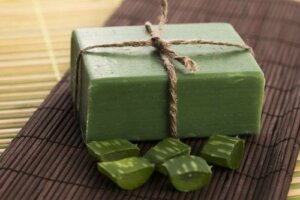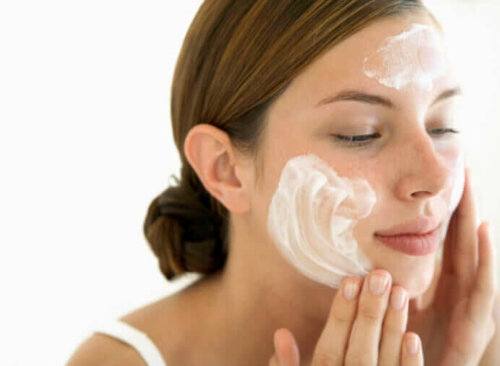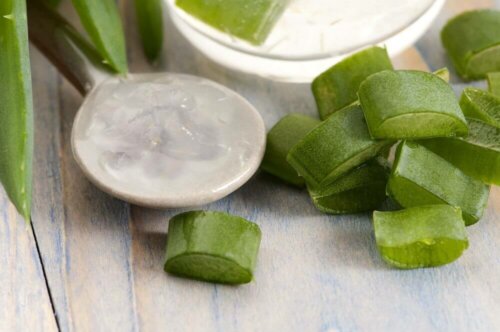How to Make Lye-Free Aloe Vera Soap

There’s such a thing as lye-free aloe vera soap and, while it’s true that this substance has been used for a long time in the elaboration of this type of product, there are several alternatives to making it. Actually, there are certain benefits to using milder formulas.
Lye has some side effects, especially in those with sensitive skin. This is because it’s a corrosive ingredient that has been associated with dermatitis, dryness, and dandruff. In fact, many companies have already stopped using it.
You may be interested in: Make Natural Soap with Aloe Vera and Honey
The advantages of lye-free soaps

Several commercial soaps contain lye and they don’t lead to bad side effects on every skin type. It’s just that some people do have negative reactions after using them. But why?
Sodium hydroxide, commonly known as lye, is an aggressive component that irritates the skin upon direct contact. It’s a common ingredient in soaps and many other beauty products, although in relatively low concentrations.
However, some entities advise consumers to avoid direct contact with this component. In addition, the Centers for Disease Control and Prevention (CDC) reports that:
Skin contact with sodium hydroxide can cause severe burns with deep ulcerations. Pain and irritation are evident within 3 minutes, but contact with diluted solutions may not cause symptoms for several hours. Solutions as weak as those that contain about 0.12% can destroy healthy skin cells within one hour.
However, in order not to create unnecessary alerts, let’s be clear in that soaps and cosmetics manufacturers use safe amounts of lye in combination with some kind of oil. This substance neutralizes the acid in the lye and keeps the skin from being burned.
Sodium hydroxide won’t pose a health hazard as long as the soap manufacturing process has been properly carried out. Despite this, its constant use could lead to dryness or irritation, and so if this is your case then you might want to avoid it and look for other alternatives.
Don’t miss out: Five Big Benefits that Aloe Vera Gel Boasts for Your Skin
Making lye-free aloe vera soap
Yes, you can purchase soaps that claim to be lye-free. However, you can only be certain of its quality if you make it yourself. So, continue reading to learn how to make aloe vera soap with all-natural ingredients. Making your own has many health benefits worth taking advantage of.
Aloe vera nourishes the skin and helps prevent itching and irritation. Its formula is gentler and appropriate for even the most sensitive skin types. In addition, the rest of the ingredients in this soap nourish, moisturize, and soften the skin.

Ingredients
- 2 tablets of glycerin soap
- 1 c. of aloe vera gel
- 4 tbsp. of honey
- 5 tbsp. of olive oil
- Lemon zest or drops of essential oil
Instructions for making aloe vera soap
- Firstly, introduce the glycerine soap bars and melt them in a microwaveable container for about 4 minutes.
- Then, add the honey, the lemon or essential oil, and the aloe vera pulp when the soap melts
- Separately, heat the olive oil until it’s warm. Keep it from overheating because it’ll lose its properties
- Then, mix all the ingredients with a hand blender (if possible) at low power until you attain a brilliant mixture with a rather pleasant aroma
- Pour the content into several soap molds or into a clean plastic container
- Finally, refrigerate the soap for a day or until it’s completely solid and cut the block into smaller bars if the mold is big
You know you’d love to make this natural soap at home! As you can see, making your own is quite simple and won’t take too much of your time. This is the ideal product for your skin and you’ll rest assured it truly doesn’t contain lye. Why don’t you try it?
All cited sources were thoroughly reviewed by our team to ensure their quality, reliability, currency, and validity. The bibliography of this article was considered reliable and of academic or scientific accuracy.
- Schatz, R. J., Debing, L., & Murray, G. (2005). SODIUM HYDROXIDE. Industrial & Engineering Chemistry. https://doi.org/10.1021/ie50506a042
- Seidenari, S., Pepe, P., & Di Nardo, A. (1995). Sodium hydroxide-induced irritant dermatitis as assessed by computerized elaboration of 20 MHz B-scan. Images and by TEWL measurement: A method for investigating skin barrier function. Acta Dermato-Venereologica.
- Eggeman, T. (2011). Sodium Hydoxide. Kirk-Othmer Encyclopedia of Chemical Technology. https://doi.org/10.1002/0471238961.1915040905070705.a01.pub2
- Oluwatoyin, S. M. (2011). Quality of Soaps Using Different Oil Blends. Journal of Microbiology and Biotechnology Research.
- Hamman, J. H. (2008). Composition and applications of Aloe vera leaf gel. Molecules. https://doi.org/10.3390/molecules13081599
This text is provided for informational purposes only and does not replace consultation with a professional. If in doubt, consult your specialist.








